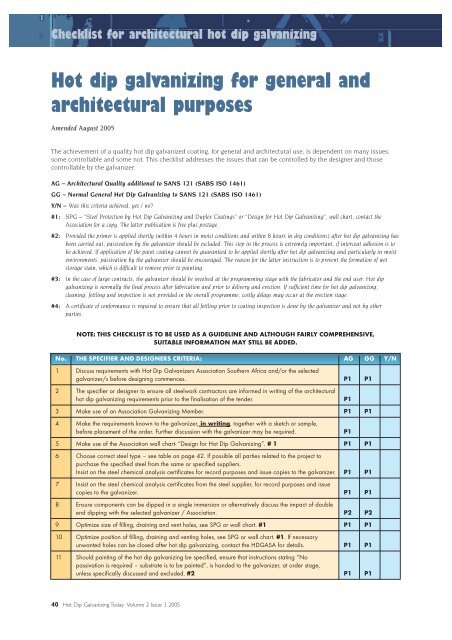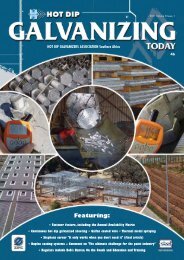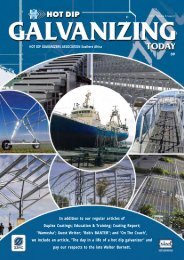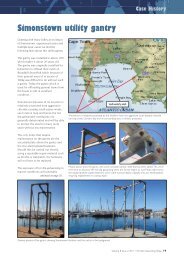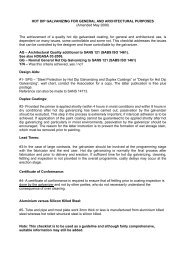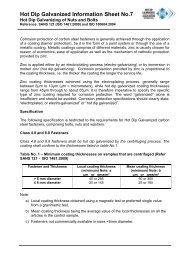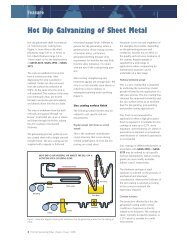Hot dip galvanizing for general and architectural purposes - hdgasa
Hot dip galvanizing for general and architectural purposes - hdgasa
Hot dip galvanizing for general and architectural purposes - hdgasa
Create successful ePaper yourself
Turn your PDF publications into a flip-book with our unique Google optimized e-Paper software.
Checklist <strong>for</strong> <strong>architectural</strong> hot <strong>dip</strong> <strong>galvanizing</strong><strong>Hot</strong> <strong>dip</strong> <strong>galvanizing</strong> <strong>for</strong> <strong>general</strong> <strong>and</strong><strong>architectural</strong> <strong>purposes</strong>Amended August 2005The achievement of a quality hot <strong>dip</strong> galvanized coating, <strong>for</strong> <strong>general</strong> <strong>and</strong> <strong>architectural</strong> use, is dependent on many issues,some controllable <strong>and</strong> some not. This checklist addresses the issues that can be controlled by the designer <strong>and</strong> thosecontrollable by the galvanizer.AG – Architectural Quality additional to SANS 121 (SABS ISO 1461)GG – Normal General <strong>Hot</strong> Dip Galvanizing to SANS 121 (SABS ISO 1461)Y/N – Was this criteria achieved, yes / no?#1: SPG – “Steel Protection by <strong>Hot</strong> Dip Galvanizing <strong>and</strong> Duplex Coatings” or “Design <strong>for</strong> <strong>Hot</strong> Dip Galvanizing”, wall chart, contact theAssociation <strong>for</strong> a copy. The latter publication is free plus postage.#2: Provided the primer is applied shortly (within 4 hours in moist conditions <strong>and</strong> within 8 hours in dry conditions) after hot <strong>dip</strong> <strong>galvanizing</strong> hasbeen carried out, passivation by the galvanizer should be excluded. This step in the process is extremely important, if intercoat adhesion is tobe achieved. If application of the paint coating cannot be guaranteed to be applied shortly after hot <strong>dip</strong> <strong>galvanizing</strong> <strong>and</strong> particularly in moistenvironments, passivation by the galvanizer should be encouraged. The reason <strong>for</strong> the latter instruction is to prevent the <strong>for</strong>mation of wetstorage stain, which is difficult to remove prior to painting.#3: In the case of large contracts, the galvanizer should be involved at the programming stage with the fabricator <strong>and</strong> the end user. <strong>Hot</strong> <strong>dip</strong><strong>galvanizing</strong> is normally the final process after fabrication <strong>and</strong> prior to delivery <strong>and</strong> erection. If sufficient time <strong>for</strong> hot <strong>dip</strong> <strong>galvanizing</strong>,cleaning, fettling <strong>and</strong> inspection is not provided in the overall programme, costly delays may occur at the erection stage.#4: A certificate of con<strong>for</strong>mance is required to ensure that all fettling prior to coating inspection is done by the galvanizer <strong>and</strong> not by otherparties.NOTE: THIS CHECKLIST IS TO BE USED AS A GUIDELINE AND ALTHOUGH FAIRLY COMPREHENSIVE,SUITABLE INFORMATION MAY STILL BE ADDED.No. THE SPECIFIER AND DESIGNERS CRITERIA: AG GG Y/N1 Discuss requirements with <strong>Hot</strong> Dip Galvanizers Association Southern Africa <strong>and</strong>/or the selectedgalvanizer/s be<strong>for</strong>e designing commences. P1 P12 The specifier or designer to ensure all steelwork contractors are in<strong>for</strong>med in writing of the <strong>architectural</strong>hot <strong>dip</strong> <strong>galvanizing</strong> requirements prior to the finalisation of the tender.3 Make use of an Association Galvanizing Member. P1 P14 Make the requirements known to the galvanizer, in writing, together with a sketch or sample,be<strong>for</strong>e placement of the order. Further discussion with the galvanizer may be required.5 Make use of the Association wall chart- “Design <strong>for</strong> <strong>Hot</strong> Dip Galvanizing”. # 1 P1 P16 Choose correct steel type – see table on page 42. If possible all parties related to the project topurchase the specified steel from the same or specified suppliers.Insist on the steel chemical analysis certificates <strong>for</strong> record <strong>purposes</strong> <strong>and</strong> issue copies to the galvanizer. P1 P17 Insist on the steel chemical analysis certificates from the steel supplier, <strong>for</strong> record <strong>purposes</strong> <strong>and</strong> issuecopies to the galvanizer. P1 P18 Ensure components can be <strong>dip</strong>ped in a single immersion or alternatively discuss the impact of doubleend <strong>dip</strong>ping with the selected galvanizer / Association. P2 P29 Optimize size of filling, draining <strong>and</strong> vent holes, see SPG or wall chart. #1 P1 P110 Optimize position of filling, draining <strong>and</strong> venting holes, see SPG or wall chart. #1. If necessaryunwanted holes can be closed after hot <strong>dip</strong> <strong>galvanizing</strong>, contact the HDGASA <strong>for</strong> details. P1 P111 Should painting of the hot <strong>dip</strong> <strong>galvanizing</strong> be specified, ensure that instructions stating “Nopassivation is required – substrate is to be painted”, is h<strong>and</strong>ed to the galvanizer, at order stage,unless specifically discussed <strong>and</strong> excluded. #2 P1 P1P1P140 <strong>Hot</strong> Dip Galvanizing Today Volume 2 Issue 3 2005
Checklist <strong>for</strong> <strong>architectural</strong> hot <strong>dip</strong> <strong>galvanizing</strong>No. THE SPECIFIER AND DESIGNERS CRITERIA: AG GG Y/N12 Select significant surfaces, highlight on drawing or sketch <strong>and</strong> discuss with galvanizer /Association. P1 P113 If necessary, hot <strong>dip</strong> galvanize a sample <strong>and</strong> establish acceptance / rejection criteria. P1 P114 Specify the correct temporary-marking pen <strong>for</strong> fabrication marking. (A 50/50 PVA paint to watermix, works well <strong>for</strong> temporary marking) P1 P115 Ensure that if permanent marking, such as welded lettering is used it will be appropriately hiddenfrom final view.P116 Specify all flame cut edges to be thoroughly ground, ideally 2mm into the parent material. P1 P117 If deemed necessary, to minimize h<strong>and</strong>ling damage ensure correctly positioned lifting lugs areprovided or if not acceptable, soft lifting slings are used, by all parties, including the galvanizer,the transporter, the off loader <strong>and</strong> the erector, etc. The use of the <strong>for</strong>mer is possibly more appropriate. P1 P118 Specify welding that is fit <strong>for</strong> purpose; do not allow over weld. P219 Should stick welding be used, ensure that all weld slag is comprehensively removed by abrasiveblasting of the weld area or grinding prior to delivery to the galvanizer. (Excessive weld porositycan have a marked effect on the quality of the hot <strong>dip</strong> galvanized coating). P1 P120 If the build-up of zinc at a weld is unacceptable <strong>for</strong> aesthetical reasons, request that the correctwelding wire or rod be used. Some welding materials are reactive wrt hot <strong>dip</strong> <strong>galvanizing</strong> <strong>and</strong>can result in a thicker coating on the deposited weld. Discuss with the HDGASA.P121 Simplify componentry –Simple structures – Better coating qualityComplex structures – Harder to manipulate in the <strong>galvanizing</strong> bath, more control, cleaning <strong>and</strong>fettling necessary. P1 P122 Simplify complex structures by making use of bolting where possible or alternatively design <strong>for</strong> after<strong>galvanizing</strong> welding, by using a suitable mask such as “Galvastop”, which can be easily cleaned,successfully welded <strong>and</strong> correctly repaired. P1 P123 Discuss packaging / dunnage requirements with the galvanizer during transport <strong>and</strong> ensure that ample sitestacking facilities are provided. A hot <strong>dip</strong> galvanized coating is applied in a factory <strong>and</strong> then transportedto site where frequently the components are thrown off the truck. Inappropriate offloading may lead tounnecessary mechanical damage of the coating. As the components are <strong>general</strong>ly not wrapped, coatingdiscolouration due to contaminants being deposited by wet trades, i.e. angle grinding of wet clay bricksin the presence of hot <strong>dip</strong> galvanized components, should be prevented. P1 P224 Discuss the appropriate repair method, if repair is deemed to be necessary, with the galvanizer.Silver spray paint is not acceptable. The silver spray paint may be initially more aestheticallyacceptable while the hot <strong>dip</strong> galvanized coating is shinny, but will ultimately st<strong>and</strong> out <strong>and</strong> beaesthetically unacceptable, when the hot <strong>dip</strong> galvanized coating begins to weather to a matt dullgrey appearance. P1 P125 Discuss the maximum size of coating repair area allowable when alterations or adjustments aremade on site, with the appropriate contractors.P126 Discuss inspection of the components prior to these leaving the galvanizer’s premises. P1 P127 Ensure that a certificate of con<strong>for</strong>mance in accordance with the specification has been obtained fromthe galvanizer. #4 P1 P128 Ensure that selected galvanizers use their appropriate identification paint, (if acceptable to theclient) be<strong>for</strong>e delivering the components to site. Furthermore, identification paint is to be appliedonly to areas identified on the drawings by the architect or consultant, or if not available innon-significant areas, particularly if the component is not to be over coated with a paint system. P2 P229 Allow sufficient time <strong>for</strong> the hot <strong>dip</strong> <strong>galvanizing</strong> process to take place, ideally 3 to 7 working days,unless other arrangements have been made. #3 P1 P1Volume 2 Issue 3 2005 <strong>Hot</strong> Dip Galvanizing Today 41
Checklist <strong>for</strong> <strong>architectural</strong> hot <strong>dip</strong> <strong>galvanizing</strong>No. THE GALVANIZERS’ CRITERIA: AG NG Y/N1 At the tender stage, enquire whether the components are to be hot <strong>dip</strong> galvanized to an <strong>architectural</strong>st<strong>and</strong>ard. If yes, ensure that the enquirer underst<strong>and</strong>s the specifier <strong>and</strong> designers criteria <strong>and</strong> has acopy of this check list.2 If an <strong>architectural</strong> finish is required, obtain a sketch indicating significant surfaces or a sample whichmay be hot <strong>dip</strong> galvanized, <strong>for</strong> discussion <strong>purposes</strong>.3 Insist on the appropriate steel chemical analysis certificates <strong>for</strong> <strong>galvanizing</strong> control <strong>and</strong> record <strong>purposes</strong>. P1 P14 Ensure that significant surfaces if necessary have been discussed <strong>and</strong> agreed on. P1 P15 Ensure components can be <strong>dip</strong>ped in a single immersion, unless discussed with the fabricator /customer / specifier or the Association. P1 P16 Ensure when offloading plain steel components, that any transport damage is recorded <strong>and</strong> theclient appropriately notified. P1 P17 Ensure that reasonable fill, draining <strong>and</strong> vent holes have been provided. P1 P18 Ensure that filling, draining <strong>and</strong> vent holes have been positioned correctly. P1 P19 When h<strong>and</strong>ling the component, make use of the lifting lugs if supplied or alternatively use soft liftingslings after hot <strong>dip</strong> <strong>galvanizing</strong>. P1 P110 Ensure the use of optimum aluminium content in the zinc bath. P1 P211 Based on the chemical analysis of the steel, discuss immediate water quenching after <strong>galvanizing</strong>, ifnecessary to limit iron/zinc alloy build-up with reactive steel. The galvanizer should also be awareof the increased likelihood of distortion with certain components when quenching <strong>and</strong> discuss thesewith the customer/ Association. P1 P112 Ensure all agreed upon significant surfaces have been cleaned <strong>and</strong> free of imperfections after hot<strong>dip</strong> <strong>galvanizing</strong>, according to instructions. P1 P113 Ensure adequate fettling of the components using appropriate methods, particularly with referenceto lumps, runs <strong>and</strong> excessive surface roughness, especially on significant surfaces, while taking carenot to excessively clean the surface, leading to uncoated areas. P1 P114 Zinc spray paint is not acceptable. Ensure that the specifier is in<strong>for</strong>med of the method of renovation ofuncoated areas that might occur due to air entrapment during <strong>galvanizing</strong> or as a result of mechanicaldamage at the galvanizer. P1 P115 Water quench if necessary to limit iron / zinc alloy build-up with reactive steel. Passivating chemicalnot to be present in quench water if subsequent painting is required. See #2 P2 P216 Ensure that inspection of the components is carried out be<strong>for</strong>e <strong>and</strong> after hot <strong>dip</strong> <strong>galvanizing</strong>, to thecustomers requirements. Issue a certificate of con<strong>for</strong>mance after hot <strong>dip</strong> <strong>galvanizing</strong>. P1 P117 Ensure that any identification paint used by the galvanizer, (unless specifically excluded by the client)is applied in an agreed upon location, or on a non-significant surface of the component. P1 P2P1P1Editorial Comment to the Architectural Check ListThe <strong>architectural</strong> check list is obviously first prize in achieving quality hot <strong>dip</strong> galvanized coatings (<strong>architectural</strong> quality) <strong>and</strong> may be difficult toachieve in all instances, however it <strong>for</strong>ms an excellent guideline as to what can be achieved in practice.The MTN Head Office project in Fairl<strong>and</strong>, seeAwards Event, was a project that initially utilizedthis check list <strong>and</strong> although not quite a 100%successful in achieving <strong>architectural</strong> hot <strong>dip</strong><strong>galvanizing</strong> in all instances, there was aconsiderable degree of success.Greater success in achieving <strong>architectural</strong> hot <strong>dip</strong><strong>galvanizing</strong> will only be <strong>for</strong>thcoming when thespecifiers <strong>and</strong> galvanizers alike communicateeffectively <strong>and</strong> adhere to the requirements of thischeck list <strong>and</strong> possibly the introduction of a nickelbased alloy to the <strong>galvanizing</strong> bath.IDEAL STEEL FOR HOT DIP GALVANIZINGINDUSTRIAL AND MINING APPLICATIONS• Silicon (Si) – 0.15 to 0.3% Max• Phosphorus (P) – 0.02% MaxARCHITECTURAL APPLICATIONS• Silicon (Si) – 0.03 Max with Phosphorus (P) – equal or less than 0.01%Or• Silicon (Si) – 0.15 to 0.25% with Phosphorus (P) – equal or less than 0.02%42 <strong>Hot</strong> Dip Galvanizing Today Volume 2 Issue 3 2005


